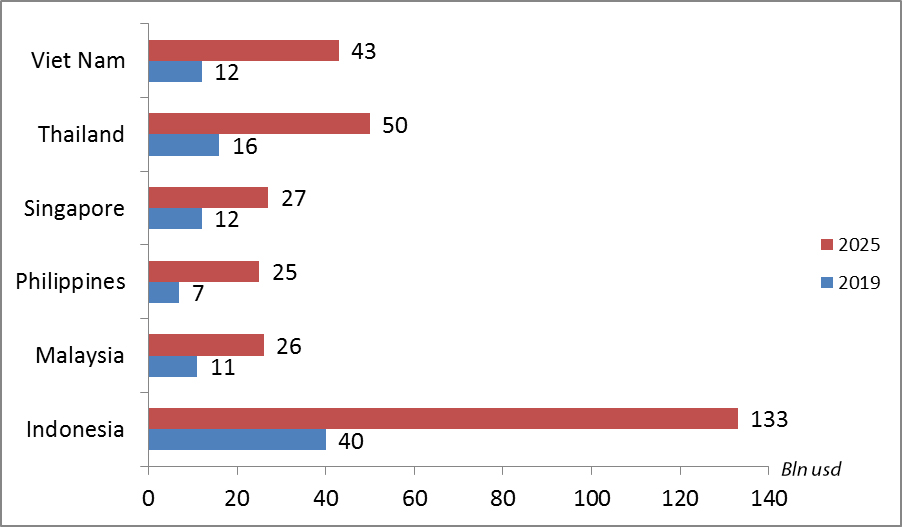Vietnam’s digital economy forecasted to reach US$43 billion by 2025
Viet Nam’s digital economy is projected to reach US$12 billion in 2019 and US$43 billion by 2025, according to E-Conomy Southeast Asia 2019 Report jointly released Thursday by Temasek, Google and Bain & Company.

|
Projected growth of Internet economy in six Southeast Asian countries
Viet Nam is one of the two fastest-growing digital economies in Southeast Asia, with the average growth rates in excess of 40% since 2015, in which e-commerce is a key driver behind the impressive numbers.
These dynamics are unlocking opportunities for entrepreneurial Vietnamese SMBs, which have jumped onboard the Internet economy to do business, says the Report.
Investor confidence in Viet Nam is on the rise. Over the last four years, Viet Nam’s Internet economy has attracted almost US$1 billion in funding, with 2019 in line to be a record year.
Viet Nam has set goal to increase the GDP share of digital economy to 20% by 2025, according to the Resolution No. 52-NQ/TW of the Politburo on guidelines for participation in the 4th Industrial Revolution.
The 2019 report covers five key sectors of the Internet economy: Online Travel, Online Media, Ride Hailing, e-Commerce, and Digital Financial Services across Southeast Asian countries.
Just over a decade ago, four in five Southeast Asians had no Internet connectivity and limited access to the Internet. Today, Southeast Asians are the most engaged mobile Internet users in the world. There are 360 million Internet users in the region and 90% of them connect to the Internet primarily through their mobile phones.
Southeast Asian people communicate with their families, friends and colleagues, entertain themselves, learn new skills and become more productive. Increasingly, they also buy products, plan trips and order food online. All of this takes place millions of times every day across the region. A vision that was almost impossible to imagine is now daily routine.
Recommended
 National
National
Closing Ceremony of 5th International Conference: Four Key Orientations to Enhance Effectiveness of Non-Governmental Aid in Vietnam
 National
National
Vietnam News Today (Dec. 5): Vietnam, China Strengthen Solidarity, Friendship
 National
National
Opening of 5th International Conference: For Prosperity and Sustainable Development
 National
National
Vietnam News Today (Dec. 4): Vietnam, Laos Aim for Deeper, Broader Partnership in New Era of Trust
Popular article
 National
National
Vietnam News Today (Dec. 3): High Political Trust Key to Fostering Vietnam-Russia Cooperation
 National
National
Vietnam News Today (Dec. 2): Vietnam Always Attaches Importance to Advancing Ties With Brunei
 National
National
Vietnam News Today (Dec. 1): Leaders of Vietnam and Brunei Wish to Expand Cooperation Across Key Sectors
 National
National



